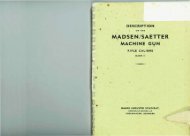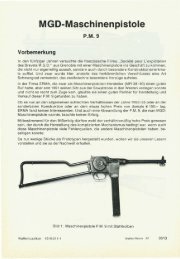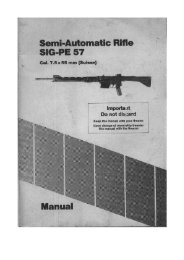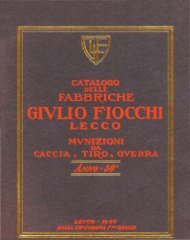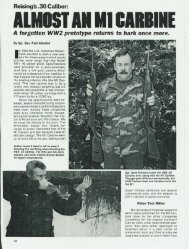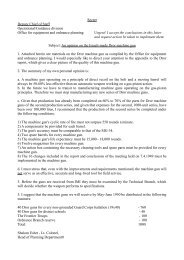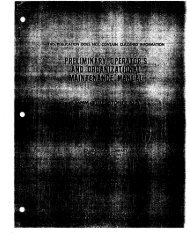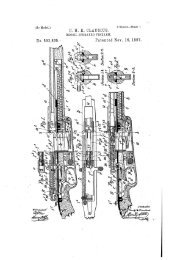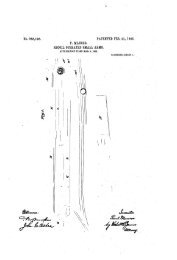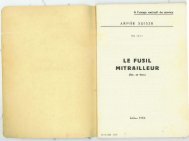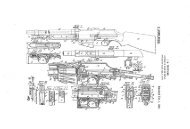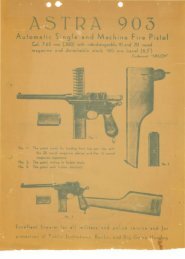The Parabellum Story (GunFacts).pdf - Forgotten Weapons
The Parabellum Story (GunFacts).pdf - Forgotten Weapons
The Parabellum Story (GunFacts).pdf - Forgotten Weapons
You also want an ePaper? Increase the reach of your titles
YUMPU automatically turns print PDFs into web optimized ePapers that Google loves.
ART THREE<br />
HE PARABELLUM STORY<br />
Mauser and Interarms started kicktg<br />
the <strong>Parabellum</strong> question around<br />
l 1962.<br />
Direktor Lubenau viewed the project<br />
vorably, but since he was nearing<br />
:tirement he felt he'd best not make<br />
decision which might well hang his<br />
.ccessor. In 1964 Direktor Adam took<br />
1er the Mauserwerke, and the Para<br />
!llum and HSc projects both got the<br />
)Sitive go-ahead. <strong>The</strong> HSc, obviously<br />
. e more manufacturable of the two,<br />
ok priority, and the M66 rifle, which<br />
this time was giving severe problems<br />
manufacturing and rather dismal<br />
:curacy, spread Mauser's engineering<br />
liT fairly thin. Mauser and Interarms<br />
presentatives met about three times<br />
year thereafter to keep up a bit of<br />
omentum.<br />
On the 21st and 22nd of February,<br />
167, Mauser held a press conference<br />
Oberndorf to which some sixty-five<br />
presentatives of the European shootg<br />
press were invited to witness the<br />
rmal unveiling of the M66 rifle. Durg<br />
the course of the conference, Mausannounced<br />
their plans to put the<br />
1ger back in production. <strong>The</strong>ir pro<br />
>sed delivery date to lnterarms of<br />
rly '67 already drifting past, they<br />
>W hoped to have it available by<br />
rly '68. It would be a faithful copy<br />
the P-08, and would retail at $300.<br />
:auser must have gagged on the<br />
1mber, for it duplicated Hebsacker's<br />
timate exactly.<br />
<strong>The</strong> P-08 was what Interarms<br />
lnted. Mauser dusted off what old<br />
:cond War blueprints and worksheets<br />
err Weiss had managed to abscond<br />
.th before the French destroyed them,<br />
td began to work from there. I recentexamined<br />
P-08 engineering drawings<br />
Mauser dated 1967.<br />
<strong>The</strong> deeper Mauser got, the more<br />
!possible the project looked. <strong>The</strong>ir<br />
oughts drifted toward Switzerland,<br />
1ravaged by war since Napoleon's<br />
ty . With the acquisition of what the<br />
viss must certainly have in storage,<br />
rhaps just slightly dusty, Mauser's<br />
:rliminary headaches and expenses<br />
ike would evaporate, and the project<br />
)Uld get back on schedule. It wasn't<br />
at easy.<br />
To start with, Waffenfabrik Bern,<br />
e obvious first stop, had been what<br />
e Swiss call a "kopfwerke"-literally<br />
mslated " head works." <strong>The</strong>y assemed<br />
the gun, and manufactured a few<br />
;entia! parts such as the receiver fork,<br />
GUNFACTS/ SEPT EMBER-89<br />
but mostly they coordinated. Actual<br />
production of the components of the<br />
Swiss Luger was farmed out to 110<br />
subcontracted firms. SIG, for instance,<br />
was the only plant which made the vital<br />
frame. In a manufacturing prospectus<br />
published sometime in the late 1950's<br />
or early '60' s, SIG had shown a<br />
photograph of a Luger frame and receiver<br />
fork, in the white, probably to<br />
illustrate the sort of intricate metalwork<br />
of which they were capable .<br />
Mauser went to the Swiss too late.<br />
<strong>The</strong> year before, 1966, SIG had hauled<br />
all their old Luger jigs, dies, and<br />
gauges out and put the torch to them<br />
-they needed the space. <strong>The</strong> machines<br />
had long since been put to other uses.<br />
Moreover, SIG was decidedly not interested<br />
in subcontracting the frame for<br />
Mauser. Besides being tied up on other<br />
work, SIG, it is widely felt in Switzerland,<br />
has always opposed a reintroduction<br />
of the <strong>Parabellum</strong> for fear it would<br />
cut heavily into sales of their own<br />
SP47 f8.<br />
Mauser wound up back at Bern.<br />
When Bern subcontracted a firm, they<br />
supplied one copy of the blueprints<br />
and one of each gauge necessary for<br />
every measurement and inspection required<br />
in manufacture. Duplicate copies<br />
of the paperwork and a set of master<br />
gauges were kept at Bern. It was<br />
up to the manufacturer to build jigs,<br />
set up his machinery, and construct<br />
as many extra gauges and so forth as<br />
were required. <strong>The</strong>se he was quite at<br />
liberty to destroy or do with what he<br />
chose at the expiration of the contract,<br />
but the original drawings and gauge set supplied<br />
by Bern had to be returned.<br />
As far as gauges and drawings went,<br />
then, the Waffenfabrik had two of<br />
everything when Mauser came knocking.<br />
An agreement was reached, probably<br />
in the fall of 1967, and the actual<br />
transfer took place around the first of<br />
December, 1967, when Mauser sent two<br />
trucks down to Bern to fetch the gear<br />
back to Oberndorf.<br />
For the not insignificant sum of<br />
$60,000 Mauser received the following:<br />
1. One copy of the entire M1929<br />
production package: blueprints,<br />
parts drawings, work sheets, tolerance<br />
calculations, etc.<br />
2 . One of each inspection gauge<br />
necessary for reading every dimension<br />
of every part in the gun.<br />
3. About 30% of the necessary jigs.<br />
4. All of the blueprints, drawings,<br />
by Jan Stevenson<br />
and calculations Bern had made in<br />
1960 when redesigning the M1929<br />
for the Swiss gunsmiths.<br />
5. Three pistols: one each of the<br />
1906 German contract model, the<br />
Swiss 06-24, and the M1929.<br />
In addition Mauser evidently bought<br />
about fifteen Model 1929 pistols on<br />
the Swiss commercial market. Bern<br />
meanwhile retains a duplicate set of the<br />
M1929 blueprings and other paperwork,<br />
and the master gauges.<br />
With this acquisition Mauser committed<br />
themselves, intellectually and<br />
emotionally at least, to produce a<br />
Swiss pattern pistol rather than the<br />
P-08 Interarms had requested. But<br />
the more Mauser engineers studied the<br />
Swiss material, the more evident it<br />
became that the Bern purchase was<br />
not the Godsend they'd hoped for.<br />
This for several reasons:<br />
Mauser's engineering and production<br />
facilities are set up in accordance<br />
with German Industry Standards<br />
(DIN). To them the Swiss blueprints<br />
seemed all backwards. Where the Swiss<br />
read a plus-only tolerance the Germans<br />
read a minus-only and so forth. <strong>The</strong><br />
blueprints would have had to be redone<br />
for this reason alone.<br />
A more serious problem was that<br />
the jigs, worksheets, etc. were geared<br />
to 1930's production methods-indeed,<br />
the way Mauser had built the gun in<br />
the same era-and a far cry from the<br />
way they' d have to do it today.<br />
For instance profilers, reading off a<br />
control die, were not used in Switzerland,<br />
nor in Germany either until the<br />
P-38 went into production at Mauser<br />
during the Second War. With the<br />
Luger, the work always moved around<br />
a static tool, rather than the tool's<br />
moving around the work. Every curved<br />
surface on the frame then was the arc<br />
described by the frame as it pivoted<br />
around to meet a cutter of a given<br />
radius. <strong>The</strong> pivot points were the<br />
holes drilled for later placement of the<br />
safety, the magazine release, the magazine<br />
base, the takedown latch, or the<br />
trigger guard. Today, of course, these<br />
same holes are used to attach the work<br />
to the jig, but the jig stays static<br />
as the pre-programmed tool moves into .<br />
the work and does what's to be done.<br />
Thus, while the Swiss were able to<br />
save time, money and bother by making<br />
the frontstrap of the Model 1929<br />
straight rather than curving it out at<br />
the bottom, such external contours




